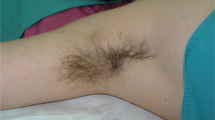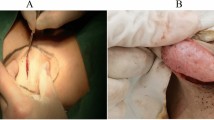Abstract
Surgical excision of apocrine glands is an effective method for the treatment of bromhidrosis. However, common postoperative complications such as skin necrosis can result in prolonged healing and unsightly scars, which are mainly caused by surgical injuries and seroma or hematoma formation. We have improved the traditional surgical methods, in the hope that the new method can not only ensure the surgical effect, but also minimize the surgical trauma and postoperative complications. Forty-four patients with bromhidrosis were included. A 1-cm incision was made in the posterior wall of the lower axilla. Tissue scissors completely separated the skin from the subcutaneous tissue of glandular distribution. Iris scissors were used to trim subcutaneous glandular tissue, until there was only full-thickness skin left. Residual glandular tissue was removed with serrated edge curettage. After adequate irrigation and hemostasis, a drainage strip was placed in the incision. Then, we evenly divided the surgical area into 8 sections. In the center of each section, a draining hole was made. Of the 88 axillae, malodor was eradicated in 84 and considerably reduced in 4. Although 6 arms had temporary edema, and 10 axillae experienced superficial epidermal necrosis, no full-thickness skin necrosis was observed. Complications like hematoma, seroma, and infection were not present in all cases. All the scars of the incision and drainage holes were inconspicuous. The use of small incisions in the posterior axillary wall could accomplish sweat gland elimination and simultaneously provide excellent drainage. Combining this with porous drainage can effectively prevent hematoma, skin necrosis, and scar formation.


Similar content being viewed by others
References
He J, Wang T, Dong J (2012) Excision of apocrine glands and axillary superficial fascia as a single entity for the treatment of axillary bromhidrosis. J Eur Acad Dermatol Venereol 26(6):704–709. https://doi.org/10.1111/j.1468-3083.2011.04149.x
Nasr MW, Jabbour SF, Haber RN, Kechichian EG, El Hachem L (2017) Comparison of microwave ablation, botulinum toxin injection, and liposuction-curettage in the treatment of axillary hyperhidrosis: a systematic review. J Cosmet Laser Ther 19(1):36–42. https://doi.org/10.1080/14764172.2016.1248438
Inaba M, Anthony J, Ezaki T (1978) Radical operation to stop axillary odor and hyperhidrosis. Plast Reconstr Surg 62(3):355–360
Li ZR, Sun CW, Zhang JY, Qi YQ, Hu JZ (2015) Excision of apocrine glands with preservation of axillary superficial fascia for the treatment of axillary bromhidrosis. Dermatol Surg 41(5):640–644. https://doi.org/10.1097/DSS.0000000000000346
Wang XW, Tang SJ, Xia Y, Chen CY, Tan WQ (2015) The modified liposuction-curettage cannula for the treatment of secondary axillary bromhidrosis with subcutaneous scarring. Plast Reconstr Surg 135(6):1077e–1079e. https://doi.org/10.1097/PRS.0000000000001235
Lee ET (2019) Shortening of incision by “pinch and turn-over technique” in the treatment of axillary osmidrosis. Aesthet Plast Surg 43(1):267–277. https://doi.org/10.1007/s00266-018-1263-2
Park YJ, Shin MS (2001) What is the best method for treating osmidrosis? Ann Plast Surg 47(3):303–309. https://doi.org/10.1097/00000637-200109000-00014
Lee ET (2018) Shortening of incision by “pinch and turn-over technique” in the treatment of axillary osmidrosis. Aesthet Plast Surg 43:267–277. https://doi.org/10.1007/s00266-018-1263-2
Leyden JJ, McGinley KJ, Holzle E, Labows JN, Kligman AM (1981) The microbiology of the human axilla and its relationship to axillary odor. J Invest Dermatol 77(5):413–416
James AG, Austin CJ, Cox DS, Taylor D, Calvert R (2013) Microbiological and biochemical origins of human axillary odour. FEMS Microbiol Ecol 83(3):527–540. https://doi.org/10.1111/1574-6941.12054
Ibrahim O, Kakar R, Bolotin D, Nodzenski M, Disphanurat W, Pace N, Becker L, West DP, Poon E, Veledar E, Alam M (2013) The comparative effectiveness of suction-curettage and onabotulinumtoxin-A injections for the treatment of primary focal axillary hyperhidrosis: a randomized control trial. J Am Acad Dermatol 69(1):88–95. https://doi.org/10.1016/j.jaad.2013.02.013
Lecouflet M, Leux C, Fenot M, Celerier P, Maillard H (2014) Duration of efficacy increases with the repetition of botulinum toxin A injections in primary palmar hyperhidrosis: a study of 28 patients. J Am Acad Dermatol 70(6):1083–1087. https://doi.org/10.1016/j.jaad.2013.12.035
Hosp C, Hamm H (2017) Safety of available and emerging drug therapies for hyperhidrosis. Expert Opin Drug Saf 16(9):1039–1049. https://doi.org/10.1080/14740338.2017.1354983
Baker DM (2016) Topical glycopyrrolate reduces axillary hyperhidrosis. J Eur Acad Dermatol Venereol 30(12):2131–2136. https://doi.org/10.1111/jdv.13745
Chen YT, Shih PY, Chen HJ, Chen TJ (2015) Treatment of axillary osmidrosis: a comparison between subcutaneous laser and superficial liposuction curettage. J Eur Acad Dermatol Venereol 29(10):2019–2023. https://doi.org/10.1111/jdv.13219
Skoog T, Thyresson N (1962) Hyperhidrosis of the axillae. A method of surgical treatment. Acta Chir Scand 124:531–538
Feldmeyer L, Bogdan I, Moser A, Specker R, Kamarashev J, French LE, Lauchli S (2015) Short- and long-term efficacy and mechanism of action of tumescent suction curettage for axillary hyperhidrosis. J Eur Acad Dermatol Venereol 29(10):1933–1937. https://doi.org/10.1111/jdv.13078
Tronstad C, Helsing P, Tonseth KA, Grimnes S, Krogstad AL (2014) Tumescent suction curettage vs. curettage only for treatment of axillary hyperhidrosis evaluated by subjective and new objective methods. Acta Derm Venereol 94(2):215–220. https://doi.org/10.2340/00015555-1671
Zhao H, Li S, Nabi O, Hu L, Gao X, Luo F (2016) Treatment of axillary bromhidrosis through a mini-incision with subdermal vascular preservation: a retrospective study in 396 patients. Int J Dermatol 55(8):919–925. https://doi.org/10.1111/ijd.13313
Liu X, Mao T, Lei Z, Fan D (2010) A simple and practical method for axillary osmidrosis resection. J Plast Reconstr Aesthet Surg 63(4):e420–e421. https://doi.org/10.1016/j.bjps.2009.11.012
Author information
Authors and Affiliations
Corresponding author
Ethics declarations
This study was conducted in the Department of Plastic Surgery of The Affiliated Hospital of Qingdao University and was approved by the hospital ethics committee.
Conflict of Interest
The authors declare that they have no conflict of interest.
Additional information
Publisher’s Note
Springer Nature remains neutral with regard to jurisdictional claims in published maps and institutional affiliations.
Level of Evidence: Level IV, therapeutic study.
Electronic Supplementary Material
ESM 1
(DOCX 28 kb)
Rights and permissions
About this article
Cite this article
He, C., Tan, L., Zhang, Q. et al. Small Incision in Lower Posterior Axillary Wall Combining Multihole Drainage Technique for the Treatment of Axillary Bromhidrosis. Indian J Surg 82, 151–156 (2020). https://doi.org/10.1007/s12262-019-01904-5
Received:
Accepted:
Published:
Issue Date:
DOI: https://doi.org/10.1007/s12262-019-01904-5




